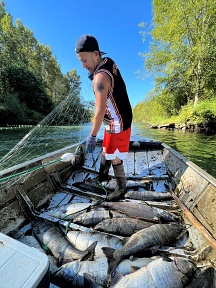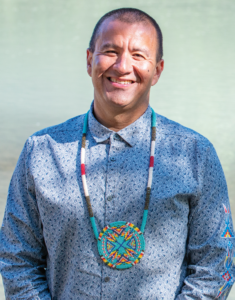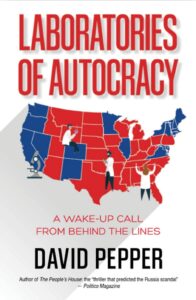Tribal Chair Willie Frank: language is the starting point
Partnering with the Nisqually tribe, the North Thurston School District plans to develop a course in the traditional Lushootseed language with the goal of offering it at River Ridge High School starting in the 2023-2024 school year. According to the district, a significant number of Native American students attend River Ridge, which currently offers Native-heritage courses, and monthly Lushootseed Lunchtime Enrichment.
Works in Progress correspondent Margaret Thomas met with Nisqually Tribal Chairman Willie Frank III in his office this fall to talk about Lushootseed in the schools. Excerpts from their 40-minute conversation appear below. They’ve been edited for length and clarity.

Margaret Thomas: Your grandfather was the last native speaker of Lushootseed. Are you learning the language?
Willie Frank: To hear him and his recordings has been really amazing. This is a language that’s different… It’s going to take years for me to learn it, so I’ve started the process… It’s the starting point, hopefully for everybody wanting to learn it. It helps make you whole when you hear that language being spoken, especially from my grandpa.
We started with our [Tribal Council] vice chairwoman, Antonette Squally. Antonette has been the [Lushootseed] teacher for the last ten years. She trained her niece and they trained four others. So now we’re building this language program. One of the cool things about it, hearing it being spoken, but also the schools being open to bring it in.
The fall of 2018, my niece came to live with my wife and I. She was going into her freshman year of high school at River Ridge in Lacey. The first day, the [then] vice principal [Mike Smith] came out to meet us. Never met him in my life.
He said, “Hey, Mr. Frank, I’ve been wanting to reach out to you. We’ve been wanting to work with the tribe. I just want to let you know, your niece—anything she needs. She’s going to be OK. We’re going to look after her.” The majority of our kids go to River Ridge. That was the starting point of this relationship with the school district. He lit the fire.
 He calls me up and says, “Hey, Mr. Frank can you come in one day; I just want to talk about building that relationship; Native American Heritage Month in November. We started getting into the classrooms at River Ridge, whether it was the history … drawing. It started slow and then it really took off. There’s a whole group of us that started getting back into the schools.
He calls me up and says, “Hey, Mr. Frank can you come in one day; I just want to talk about building that relationship; Native American Heritage Month in November. We started getting into the classrooms at River Ridge, whether it was the history … drawing. It started slow and then it really took off. There’s a whole group of us that started getting back into the schools.
It’s about trust. I saw our kids really struggling, because they didn’t see anybody who looked like them coming into the schools. A group of us would come into the schools and spend days. We’d get in at 7:30 and we’d be out at 2. Every classroom, we’d go 50 minutes. We’d have one section where we would talk about treaty rights. We’d have one where we would talk about early, early history. Then we’d have one (about) culture, traditions.
People were like, “Can you guys develop curriculum?” That’s how it started in 2019, right before covid. We had the land acknowledgement agreement. The school board and the superintendent they signed off on it. We have the Nisqually flag hanging at all the schools in the district. [We had] 80 teachers from North Thurston High School and administrators … up at the [tribal] Culture Center. So we’re teaching the administrators and the principals. Just getting them accustomed to Nisqually history. Now he language is taking off. The language will be offered in some schools in 2023. It’s going to be a pilot and we’ll see how it goes.
Then of course we got our Head Start program over here where we’re getting our kids in early. Most of our kids start out at Wa-He-Lut [Indian School]. That was one of my Grandpa’s dreams–he wanted to see the school, us speaking the language. We have kids’ books in our language.
From his phone, Frank plays a short recording of his grandfather, Willie Frank Sr., telling a traditional story, “our mountain story,” first in Lushootseed and then in English.
MT: Why is offering Lushootseed in the schools important to you?
Frank: It’s showing the next generation who we are. Our language was definitely frowned upon in my grandfather’s generation—he was born in 1879. I think about that. What he went through in his life, and then my father. I’d always ask my dad, “How come you never taught me the language growing up?” And he’d say, “Your grandfather didn’t want us speaking it because of what was happening to them in the boarding schools.” It made sense.
When [our tribal kids] see it being taught in the schools they’re going to be like ‘Oh man, I really want to learn this. This is ours.’ A lot of healing is a part of it, too. That was one of the things we thought about: Should we even offer this to non-Native kids—we want our own kids first. We’re going to see how it goes, but we’re willing to do anything to make sure people understand who we are as Native people, and as Nisqually people.
A lot of people right now want to learn about tribes. One of the things that frustrated me growing up was what we learned in the schools. You take Washington State history and you learn one week on tribes in the area, usually talking about the bigger tribes. For us here, in Nisqually and in the South Sound, the fishing wars and Medicine Creek Treaty, where the Treaty Tree is, that’s really the center of the universe.
This is huge for us: Survival. I think the language is going to be the biggest thing moving forward [along] with the natural resources. The survival of Native people in general. It’s being spoken; it’s being taught everywhere up and down I-5. You’re seeing a lot of our tribes trying to get their members back into it. You’re hearing it spoken in the governor’s office in the Capitol.
You think about relations with the tribes and the State in the last 50 years—we’re coming up on the fiftieth anniversary [of the Bolt Decision] in 2024—and to think our language is going to be offered in the schools. Maybe it doesn’t work. Maybe it does. It’s in there, and our curriculum is starting to get in. It takes time. One of the things my dad always said is, “Being an Indian you’ve got to have a lot of patience.” And, goddamn, he was right about that.
[Native Student Program Specialist] Jerad Koepp took some heat when he first got hired … but he was one man for 22 schools. He hung in there: He won [Washington State] Teacher of the Year last year.
MT: Did your own experience as a Nisqually student influence your interest in the program?
Frank: Back in 2000 when I graduated, I never thought I’d be back in the schools, teaching some of the teachers that taught me. It’s been good to hear their feedback. They’re like, “We’re proud of you, man. We like learning this stuff.”
I try to grow and learn every day, I figure that’s a true education. For tribes, there’s so much opportunity. Our kids, we give them the opportunity to go to school. We pay for their college. We’re going to be sitting at the table—all of our tribes.
MT: How do Nisqually students benefit from the Native Studies program, especially learning the language?
Frank: Getting our kids engaged in our own history is going to be huge, and it’s challenging at times. That’s why we start so young. We start with Head Start and daycare. We got our kids down at Wa-He-Lut learning from kindergarten. They hear it every day. These kids practice singing and dancing and drumming before they go home. Council should probably do that every day, too.
I really believe it’s a time for our tribe. I don’t want this next generation of kids to think that we’re only casinos … firecrackers, smoke shops, whatever. I want them to really understand who we are as the Nisqually people; our culture, our way of life. I don’t even care if we do anything else. It’s about us setting the example for that next generation.
MT: How will other Native students and non-Native students benefit?
Frank: We live in an area where it’s not just the local tribes. Since [Joint Base Lewis-McChord] is so close, we have folks from all over Indian country here. It’s good for Native kids to see this and hear this in the classroom. …whether you’re from the Dakotas or the East Coast or down South. I hope…as time goes on, our Native kids look at it as ‘we’re all Natives, we’re all Native American people.’ We’ve got to come together. I’m not saying that what’s good for one tribe is good for every tribe, but there’s so much out there that we have as similarities rather than differences.
MT: Is there anything else you want to add?
Frank: I want our kids to be proud to walk into the schools. That’s why we do this.

Be First to Comment